- Skip to primary navigation
- Skip to main content
- Skip to primary sidebar
Licensed Tour Guide in Italy

Dante — A Literary Walking Tour
August 18, 2019 By Chandi Wyant
Dive into Dante’s Florence
Dante was a genius poet, the father of the modern italian language, and the most important literary figure in all of italy’s long history..
Explore with me Dante’s neighborhood, see where he lived, was baptized, and fell in love. I’ll show you the Palazzo of the Wool Guild that contains a Dante Library where his masterpieces are studied, and the place where the Divine Comedy was read aloud for the first time in public. Learn about Beatrice, his muse, and about his heartbreaking exile from Florence on this two hour walking tour through the heart of Florence.
Options: Choose to add on Dante-related frescos in locations of great historical significance in the city. There is an additional entrance cost and additional time of approximately 30 to 40 more minutes.
Contact Chandi For More Details
Tour Info Contact Form
For other tour offerings go here
Related Tours
An Orientation and Introduction to Fabulous Florence Learn how and why the Renaissance began in…
Visit the Most Local and Unchanged Market in the City Explore the intersection of food…
Up Close With One of the Greatest Artists of All Time This three-hour tour will…
Tagged With: art history tours , Dante , Dante frescoes , Dante tour , Divine Comedy , Florence tour guide , Florence tours , Italian language , Italy tour guide , Literary tours , Tour Florence , Tours in Italy , visit Florence
Privacy settings
With the slider, you can enable or disable different types of cookies:, this website will.
- Remember which cookies group you accepted
- Essential: Remember your cookie permission setting
- Essential: Allow session cookies
- Essential: Gather information you input into a contact forms newsletter and other forms across all pages
- Essential: Keep track of what you input in a shopping cart
- Essential: Authenticate that you are logged into your user account
- Essential: Remember language version you selected
This website won't
- Remember your login details
- Functionality: Remember social media settings
- Functionality: Remember selected region and country
- Analytics: Keep track of your visited pages and interaction taken
- Analytics: Keep track about your location and region based on your IP number
- Analytics: Keep track of the time spent on each page
- Analytics: Increase the data quality of the statistics functions
- Advertising: Tailor information and advertising to your interests based on e.g. the content you have visited before. (Currently we do not use targeting or targeting cookies)
- Advertising: Gather personally identifiable information such as name and location
ho visto firenze - a literary guide to florence italy
- TOURIST INFORMATION
- ART & HISTORY
- UFFIZI GALLERY
- TUSCAN RECIPES
- FLORENCE HOTELS
A literary guide to Florence
Ho visto Firenze is, then, a very particular kind of guide, which talks about many of the city�s familiar sights like Palazzo Vecchio and Boboli, Fiesole and the Cascine Park, but does so through the words of 36 authors of various nationalities and periods, including the likes of Mark Twain , Theodor Mommsen and Mary Shelley .
Visiting Florence and allowing yourself to be guided by the words of others, looking for similarities in one�s feelings and sensations, is sure to be an experience worth trying...
Published for the APT of Florence by Gallucci Editore, the volume consists of texts (in Italian and English) selected by Maurizio Bossi and fine, delicate illustrations by Giuliano Ferri.
From Apt - Agenzia per il Turismo di Firenze (Florence Official Tourist Office)
� Video of "Ho visto Firenze" presentation on YouTube
© 1996–2014 your way to florence - the right way to find resources about florence, italy
spotlight archive | reviews | our network | sitemap
see also: Your Way to Tuscany - the best way to find tuscany accommodations
- Submissions
Newsletter Signup
Sign up to receive emails about upcoming events, site updates, and other news!
What is your Favorite Book or Author?
Where do you want to travel to?
Yes, I would like to receive emails from Literary Traveler. (You can unsubscribe anytime)

The Tumultuous Relationship Between Dante and the City of Florence
- November 30, 2007
- No comments
- 5 minute read
by Rachel McGinnis
Dante Alighieri, perhaps one of the greatest poets of the medieval period, was born in 1265 into an affluent Italian family. Having nobility, ancient lineage, and a widely respected name, the only thing the Alighieri family lacked was money. To compensate for this financial deficit, Alighieri’s parents, Alighiero de Bellincione and Bella degli Abati, arranged for twelve-year-old Dante, to eventually marry Gemma di Manetto Donati, a distant relative from Corso, Italy. Receiving a sizable dowry, Dante married Gemma as a young adult, had four children with her, studied at the University of Bologna, and authored several pieces of literature, such as Commedia , the poet’s best-known work.
The poem tells of the protagonist’s journey to various nether regions while accompanied by the Roman poet, Virgil. The epic tale is based largely on the time Dante spent in a politically unstable Florence, an instability that was largely attributable to differences in religious opinions of powerful political factions. The first combatants, Ghibellines, consisted of individuals best described as “pro-imperial.” The second sect, the Guelphs, supported the Pope as the supreme ruler in place of the emperor. Although Florence was continuously plagued by the presence of a deep political rift, conditions worsened at the beginning of 1300 when the Guelphs fragmented and split into two separate factions, the Neri (Black) Guelphs and the Bianchi (White) Guelphs, giving way to three unique factions battling for political supremacy. The Black Guelphs maintained their doctrine of unflagging support for the Pope’s dominion over the Catholic Church while the White Guelphs became increasingly wary of Papal influence. Dante, then roughly thirty-five years old, joined the White Guelphs, a fact that did not go unnoticed by the then-current Pope, Boniface VIII.
During his time in Florence, the poet served the city on a number of public councils. Following the Ordinances of Justice, a doctrine requiring all public officials to be a member of the “Arts,” the poet joined the guild of physicians and apothecaries. On May 7, 1300, Dante was elected to serve a two-month term as one of six priors that formed the Signoria, the chief magistracy of Florence. During his tenure, the author furthered the anti-Papal causes of his predecessors, banished the leaders of both warring factions, and was overtly opposed to various members of the papacy.
Shortly after the conclusion of his term, however, the Black Guelphs regained power and Dante was one of the first traitors to be targeted for revenge. Black Guelph leaders made trumped-up, false accusations against Dante of hostility toward the church and corruption of a public office. As a result, Dante was fined and banned from further public service in Florence. The poet was further condemned as contumacious and sentenced to be burned to death should he ever fall into the hands of the proper authorities. Unhappily driven from his beloved Florence, Dante spent the remainder of his life traveling, seeking protection from various nobles, and composing The Divine Comedy , a work that has become known as the epic poem of Italian Literature.
Originally named Commedia ( Comedy ) by Dante, the poem became known as La Divina Commedia ( The Divine Comedy ) in 1555, in an edition produced in Venice. It is composed of an introductory canto (Canto I) followed by three canticas, namely Inferno , Purgatorio , and Paradiso , which each have thirty-three cantos, thereby totaling 100 canti for the entire poem. Inferno , the first cantica, has been described as the most resounding segment of the poem, largely due to its memorable images and abrasive treatment of 13th century Florence. The poem is based on Dante’s journey through the Inferno, in which sinners are punished according to a graded moral scale–the more appalling the sin committed, the lower the circle to which the sinner was condemned.
Perhaps one of the most resounding and repeated elements of the poem is Dante’s poor depiction of Florentine citizens, a fact that clearly reveals that no love was lost between the poet and the great Italian city. In fact, Dante and Virgil do not encounter a Florentine citizen until they reach the third circle. After Dante’s initial recognition of this fellow citizen, however, the remainder of the poem is riddled with allusions to shades from Florence. Dante’s most poignant reference appears in Canto XXVI, when he enthusiastically declares,
Florence, rejoice, now that you have such fame, And over land and sea you spread your wings! The whole Inferno’s ringing with your name!
Critics have attributed the author’s negative illustration of this Italian city to his eventual disillusionment with both the politics of the city and the city itself.
Since its conception, The Divine Comedy has elicited more than fifty English-language translations in the twentieth-century alone. It has, in effect, made Dante Alighieri into an Italian institution. The author died in Ravenna at the age of fifty-six in September of 1321, after possibly contracting malaria while on a diplomatic mission to Venice, just a few months after finishing the final cantica of his great comedy.
The poet’s funeral was held at the Church of San Pier Maggiore in Ravenna, now known as the San Francesco, a Franciscan monastery that sits on the Via Corrado Ricci in Ravenna. This basilica, built in 1230, is still a major place of pilgrimage that is widely renowned for the astounding artwork found throughout the interior of the religious monument. The Renaissance structure boasts a dim, crypt-like church on the lower half that is lit by beautiful, relatively opaque stained-glass windows, some of which are as old as the church itself. The upper half of the church provides a striking contrast to the lower region with its translucent stained glass that enhances the upper frescos with a flood of light.
The poet’s tomb, which sits just outside San Francesco, was constructed in 1780. It is decorated with various marble relief sculptures and the inscription reads, “DANTIS POETAE SEPVLCRVM,” which indicates that it is the tomb of the poet, Dante. A number of epitaphs adorn the interior of the tomb, having been periodically added over the years. Dante’s sarcophagus is engraved with the words:
JVRA MONARCHIAE SVPEROS PHLEGETHONTA LACVSQVE LVSTRANDO CECINI VOLVERVNT FATA QVOVSQVE SED QVIA PARS CESSIT MELIORIBVS HOSPITA CASTRIS AVCTOREMQVE SVVM PETIIT FELICIOR ASTRIS HIC CLAVDOR DANTES PATRIIS EXTORRIS AB ORIS QVEM GENVIT PARVI FLORENTIA MATER AMORIS.
The epitaph roughly translates to:
The rights of Monarchy, the Heavens, the Stream of Fire, the Pit, In vision seen, I sang as far as to the Fates seemed fit; But since my soul, an alien here, hath flown to nobler wars, And, happier now, hath gone to seek its Maker ‘mid the stars, Here am I Dante shut, exiled from the ancestral shore, Whom Florence, the of all least-loving mother, bore.
Following the wide-spread success of Dante’s Commedia , Florentine officials began to understandably regret the exile of one of its greatest citizens. Religious and political leaders repeatedly demanded the return of Dante’s remains, even eliciting the assistance of the Pope in hopes of swaying the citizens of Ravenna. Nevertheless, the custodians of Dante’s remains in Ravenna refused, leading the city of Florence to construct a tomb at the basilica of Sante Croce, which has remained empty since its construction. The tomb reads, “Onorate l’altissimo poeta,” which translates to “Honor the most exalted poet”–a line that may seem oddly familiar to readers of Dante’s Inferno , given its appearance in Canto IV.
Related Topics
- Divine Comedy
- San Francesco
- San Pier Maggiore
- Sante Croce
- Via Corrado Ricci
Rome’s Ultimate Guidebook: I, Claudius
Literary traveler holiday gifts.
- December 13, 2007
You May Also Like
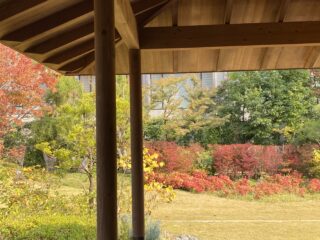
Kyoto: Where the Cuckoo Calls
- March 18, 2024
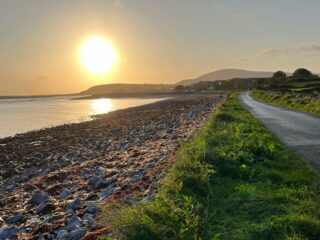
Don’t Be Afraid: A poem becomes a treasure map in Ireland
- March 4, 2024
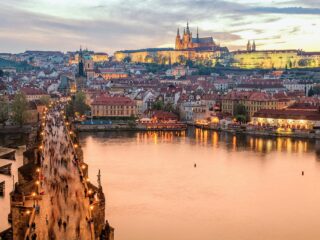
Seeking Slowness
- February 29, 2024
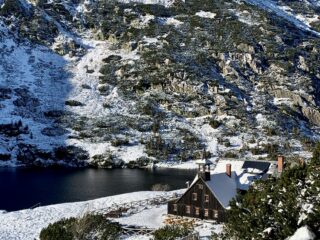
A Moment of Glory in Communist Poland
- February 3, 2024

Freya Stark’s Afghanistan
- January 20, 2024
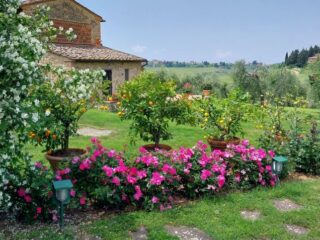
Tales from Tuscany
- August 6, 2023

Literary Traveler is Celebrating 25 Years
- July 31, 2023
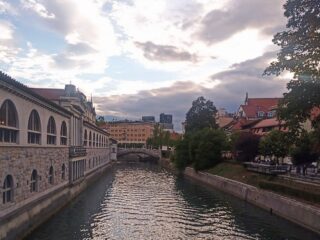
I Know Slovenia Where Veronika Decides to Die
- July 30, 2023
Leave a Reply Cancel reply
You must be logged in to post a comment.
Input your search keywords and press Enter.
Best Literary, Art & Music Tours in Florence for Seniors
- Cultural & Theme Tours
- Literary, Art & Music Tours
- Archaeology Tours
- Architecture Tours
- Ghost & Vampire Tours
- Historical & Heritage Tours
- LGBT Friendly Tours
- Movie & TV Tours
- Adventurous
- Recommended
- Most visited
- Dog friendly
- Travel Tips
- Attractions
- Things to do
- Food & Wine
Art & Culture

Rest of the world
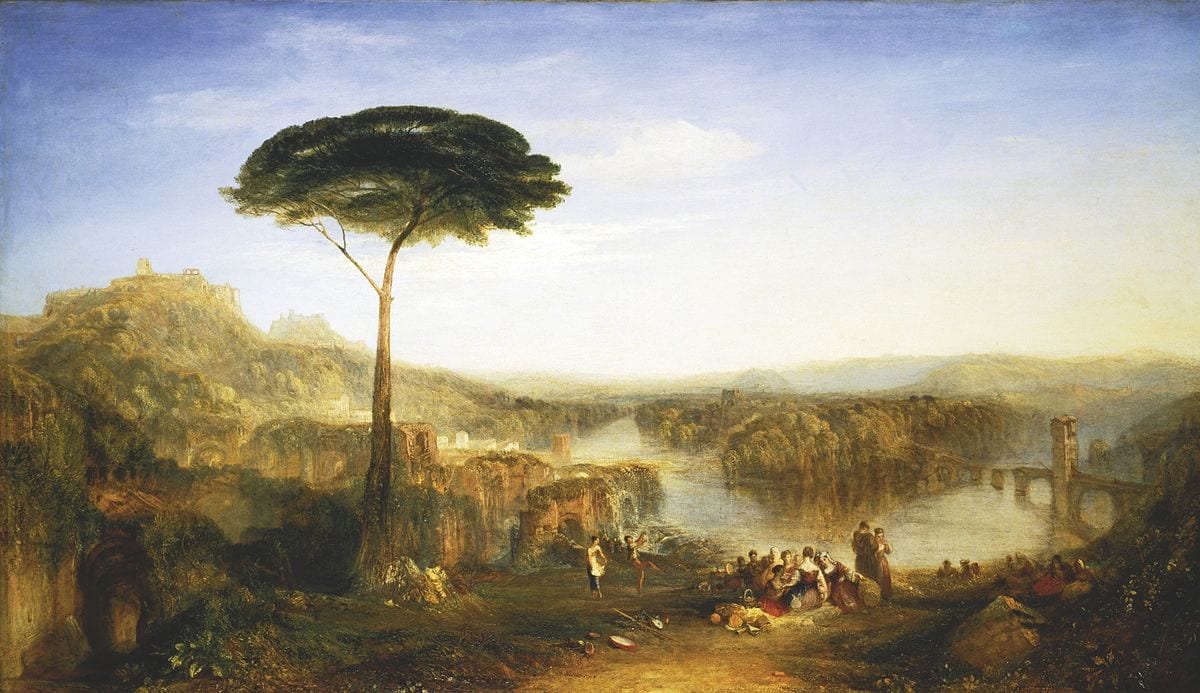
A Literary Tour of Italy: Travel in the Footsteps of Your Favorite Writers
July 17, 2023
A century before Paris became Europe’s expat literary hot spot, Italy was the place to be for English-speaking scribes. During the 19th century, novelists, poets, journalists and assorted scribblers flocked to Italy for the price, the pace, the view and/or the inspiration they found there. The World Wars of the 20th century took some of the romance (or perceived romance) out of traveling Italy but it remained a favorite place to visit and write about for some of the most talented authors of the turn of the century. From a cradle of art and culture to a “paradise” despoiled by war, Italy has been many things to many writers. Their books on Italy have played a huge role in influencing the way that modern travelers see and experience the country.
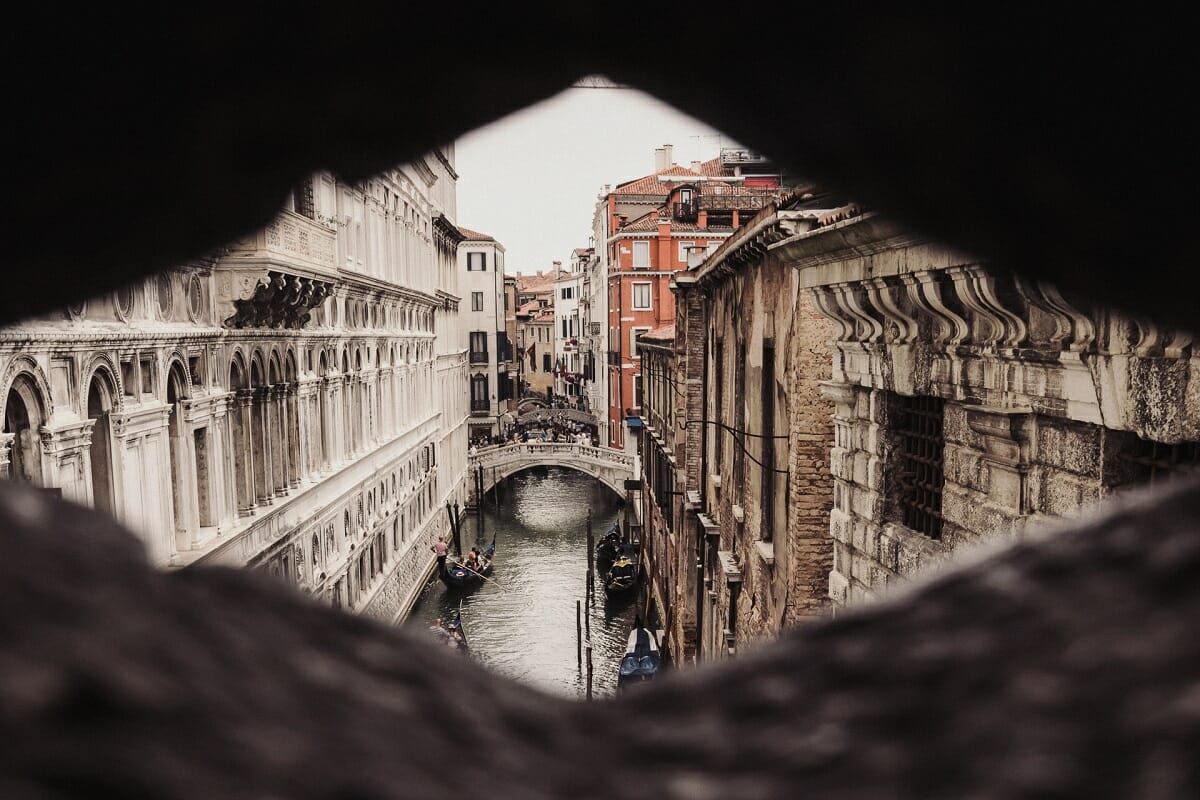
It’s easy to see why cities such as Venice left their mark on artists over the centuries. See which writers were impaced in our Literary Tour of Italy!
Want to travel Italy footsteps of some of your favorite scribes when you visit Italy? Here’s a guide to get you started.
Table of Contents
Sicily: Johann Wolfgang von Goethe
We know most people’s idea of a nice beach read isn’t Goethe, but the writer and statesman was one of the first and most famous writers to publish a popular account of his travels through Italy. From 1786 to 1788 he traveled the length of the peninsula, hitting many of the sites frequented by the young, wealthy Europeans who flocked to Italy on their Grand Tours. Goethe, however, went a step further and traveled to Sicily. He was so entranced by the island – which had very few visitors at the time – that he famously wrote, “To have seen Italy without having seen Sicily is to not have seen Italy at all, for Sicily is the clue to everything.”
His diary during the first year of his travels formed the backbone of his book on Itay, Italian Journey , published in 1816. It also inspired an influx of German youth to follow in his footsteps.
How to follow in Goethe’s footsteps: Visit the ruins at Segesta and Agrigento with your copy of his Goethe’s Italian Journey . These two spots were particular favorites of his in Sicily and his passages on them are a delight to read. Also, don’t miss Mt. Etna !
Venice: Lord Byron
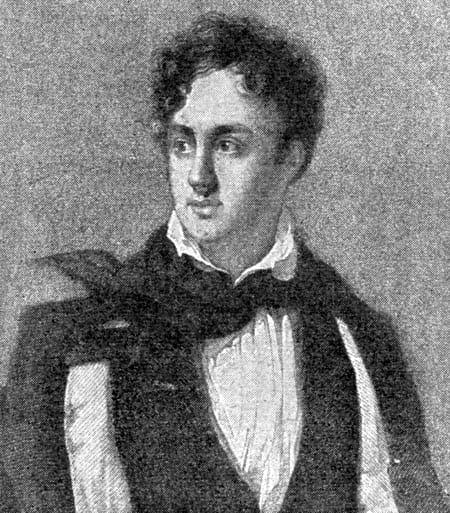
Lord Byron, the original Don Giovanni? Photo from WikiCommons
Lord Byron, the famous literary bad-boy of the 19th century is also the Romantic writer with the deepest connection to Italy. During his 6 years living in the country, he invited many other writers to stay with him, forming a veritable community in the country akin to Paris’ writers’ community of the 1920s.
His relationship to the country began when he left England in 1816 to escape various social scandals surrounding debts and his more or less constant sexual escapades. There he learned the language, dabbled in politics and became (in)famous, yet again, for his various liaisons with women, many of whom were married.
He lived in Ravenna between 1819 and 1821 in order to be close to Teresa Guiccioli, a local noblewoman who eventually left her husband to be with Byron. As a poet, he never wrote a comprehensive book on Italy but In Ravena, he continued work on Don Juan and wrote The Ravenna Diary, My Dictionary, and Recollections. He ultimately finished Cantos 6–12 of Don Juan in Pisa. (Shelley once wrote that Byron’s house in Pisa had “ten horses, eight enormous dogs, three monkeys, five cats, an eagle, a crow, and a falcon; and all these, except the horses, walk about the house.” He later added that there were also 5 peacocks, 2 guinea hens and an Egyptian crane.) Lord Byron traveled extensively throughout Italy, often with his writer friends, especially Mary and Percy Shelley, but his final Italian home was Genoa.
How to follow in Byron’s footsteps
It was Byron who introduced the term “ Bridge of Sighs ” to the English language; a translation of the Italian Ponte dei Sospiri . Go see the bridge in Venice at sunrise and take along a copy of Childe Harold’s Pilgrimage. As you look at the bridge, soak up his immortal opening to the third stanza:
I stood in Venice, on the Bridge of Sighs, / A palace and a prison on each hand: / I saw from out the wave her structures rise / As from the stroke of the enchanter’s wand: / A thousand years their cloudy wings expand / Around me, and a dying Glory smiles / O’er the far times, when many a subject land / Looked to the wingéd Lion’s marble piles, / Where Venice sate in state, throned on her hundred isles!
If you want to see Venice with an expert local guide, check out Walks of Italy’s Venice walking tours .
The Mediterranean Coast: Percy and Mary Shelley
The English Romantic poet Percy Shelley and his wife, Mary Shelley (the author of Frankenstein) lived throughout Italy from 1818 –1823. Like Byron, they were essentially social exiles, having entered into a messy affair that saw Percy’s first wife eventually commit suicide. Italy provided both anonymity and freedom from the social ostracism that awaited them in England. In fact, both of the Shelleys were able to produce a wide body of work in the 5 to 6 years that they lived there, despite personal problems, namely enduring the deaths of two of their children.
They first headed to Venice to meet Lord Byron. There, Percy wrote Julian and Maddalo , a poem nearly entirely modeled off of his conversations with Byron in the canals of Venice.
The Shelley’s lived for brief periods in Venice, Naples, Florence, and Pisa. Percy finished Prometheus Unbound while in Rome and the tragedy The Cenci while living in Livorno. In the meantime, Mary wrote Matilda , an autobiographical novel, Valperga , a historical novel, and the screenplays of Proserpine and Midas.
Unfortunately, Percy Shelley died when his sailboat capsized in a storm near Viareggio. After his death, Mary went to live in Genoa for a time before ultimately returning to England. Years later, Mary produced a travel book on Italy entitled Rambles in Germany and Italy . Despite all the hardship, she once described Italy as, “a country which memory painted as paradise.”
How to follow in Shelley’s footsteps
One of Mary Shelley’s favorite Italian views came when she crossed the Simplon Pass – a mountain pass connecting Italy to Switzerland. You can still walk it today and if you go in the summer there are are few better hikes in the Alps. Wordsworth was also a fan.
Trieste: James Joyce
The turn of the century changed the literary milieu in Italy considerably. James Joyce arrived in 1904, 22 years old and penniless. He taught English in the city and constantly invited others to join him – not the least because he wasn’t making enough money to support his family and needed someone a bit more career-minded to help hold the fort. First, his brother came out to help with expenses, then two of his sisters arrived to help his wife run the house. Throughout his time there Joyce tried many different money-making schemes and never gave up his drink, but the Adriatic port surely inspired the young author. He wrote most of Ulysses and all of A Portrait of the Artist as a Young Man while living in Trieste.
He tried to move to Rome only once: he hated it and returned to Triest before the year was up. As a consummate writer of “everymen” Joyce found plenty of inspiration in Trieste. The port city was filled with laborers, sailors and local workers from all over Europe. It’s even said that the local dialect influenced the more complicated language texts of Ulysses.
Though he lived there just 10 years, the author and the city shared a remarkable creative bond.
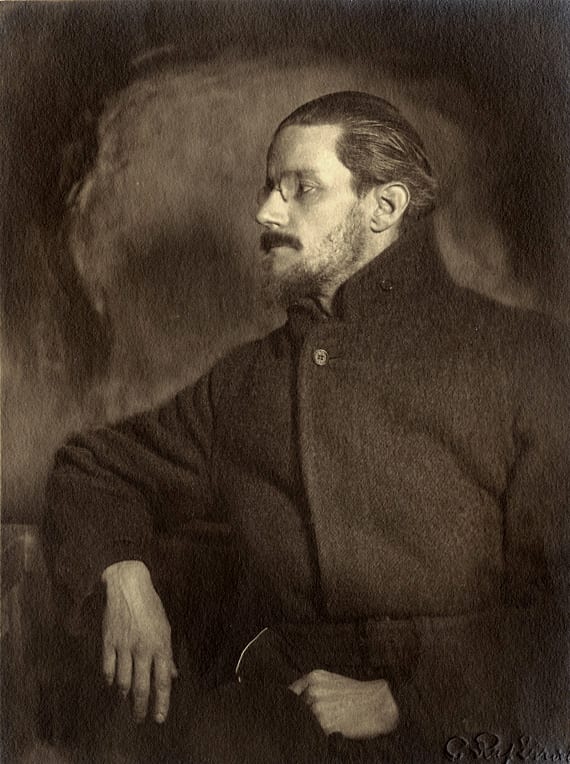
Joyce. Photo from Wikimedia Commons
How to follow in Joyce’s footsteps
Today, Trieste is home to the Museo di Joyce , a museum showcasing the rich connections between Joyce’s work and the city. Spend the morning there then head to either the Caffè San Marco, or the Caffè Stella Polare – two of Joyce’s favorite haunts – for a coffee and some conversation.
Friuli-Venezia Giulia: Ernest Hemingway
Hemingway’s travels in Cuba, Spain, and Africa have become so legendary that it’s easy to forget his first novel, The Sun Also Rises , is based on his experiences in Northern Italy. In 1918 Hemingway volunteered to be an Ambulance driver for the allies in the First World Wart and within six months he was in Friuli-Venezia Giulia on the Italian Front. His time spent, both on battlefields and convalescing from a wound became the basis of The Sun Also Rises. His experiences also worked their way into his nonfiction, like an oft-cited passage in Death in the Afternoon about picking up the remains of people who had been blown up in a munitions factory explosion.
Later, when Hemingway set up house in Paris, he still made frequent trips to Italy with his first wife Hadley. In fact, the third story in his first book, Three Stories and Ten Poems , was written while he was spending the spring in Italy. Years later in 1948, the author and his third wife Mary traveled to Venice where they stayed for several months. His love affair with 19-year-old Adriana Ivancich inspired his novel Across the River and into the Trees, his only other book set in Italy.
How to follow in Hemingway’s footsteps
If you are traveling in style head to Stresa on Lake Maggiore , an hour’s drive from Milan. There you can check into the Hemingway Suite – the same room (now somewhat spruced up) that he stayed in while on leave from his time as an ambulance driver on the Italian front. You can even see where he signed his name in the guest book on a return journey.
Tuscany: Joseph Heller
Joseph Heller also saw active service on the Italian front, but in the Second World War, instead of the First. His experiences in the airforce there gave him the raw materials for his classic anti-war novel, Catch-22. Though you would be forgiven for not remembering this, most of the events of Catch-22 are set on the island of Pianosa, which sits off the coast of Tuscany.
Although Catch-22 is more of a satire than a book on Italy, we didn’t want to miss this opportunity to mention Pianosa because its one of our favorite islands in the Tuscan Archipelago and well worth a visit. Actually used as a penal colony and high-security prison until 1997, it is now a protected island open to only 250 visitors a day. For more trips around Tuscany check out our Tuscan driving tours from Florence and Rome .
How to follow In Heller’s footsteps
A day on Pianosa is one of the most enjoyable things to do on the Tuscan Archipelago. As one of the most secluded islands in the chain it’s a real hidden gem. While we do recommend reading Catch-22, it won’t remind you very much of the actual island.
Modern-Day Authors on Italy
Though these authors were some of the first to be widely influenced by Italy, they certainly weren’t the last. Today writers are still traveling to the country for healing, meditation, food and ultimately, inspiration. For written accounts of more recent sojourns to Italy, check out modern classics like Under the Tuscan Sun, A Thousand Days in Venice, Beautiful Ruins, and the ever popular Eat Pray Love.
Want to add some Italy books to your summer reading list? Check out our list of the 10 indispensable Books on Italy .
by Gina Mussio
Book a tour.

Pristine Sistine - The Chapel at its Best
1794 reviews

Premium Colosseum Tour with Roman Forum Palatine Hill
850 reviews

Pasta-Making Class: Cook, Dine Drink Wine with a Local Chef
121 reviews

Crypts, Bones Catacombs: Underground Tour of Rome
401 reviews

VIP Doge's Palace Secret Passages Tour

Legendary Venice: St. Mark's Basilica, Terrace Doge's Palace
286 reviews
You May Also Like

October 14, 2019
Listen up! 5 Fascinating Podcasts on Ancient Rome
Here we take a look at the best podcasts on Ancient...
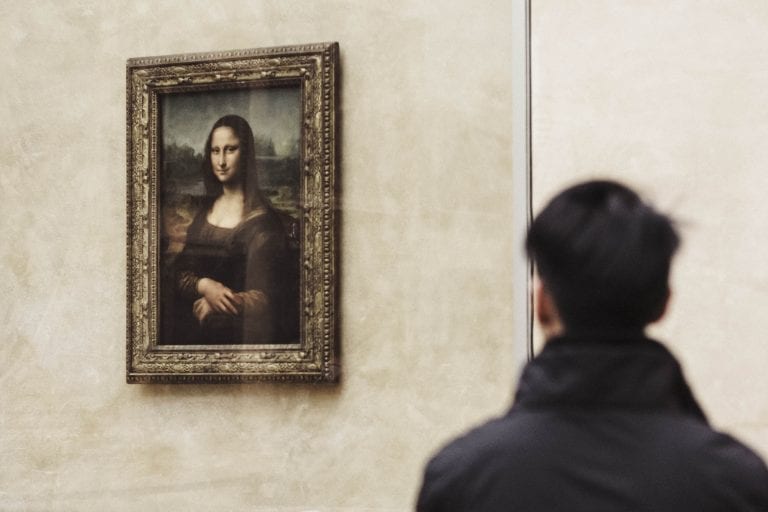
December 19, 2019
From Ancient to Modern Art: 7 Art History Podcasts to Download ASAP
Ask any two people their opinion of the same piece of art work, and you’re likely to elicit two...
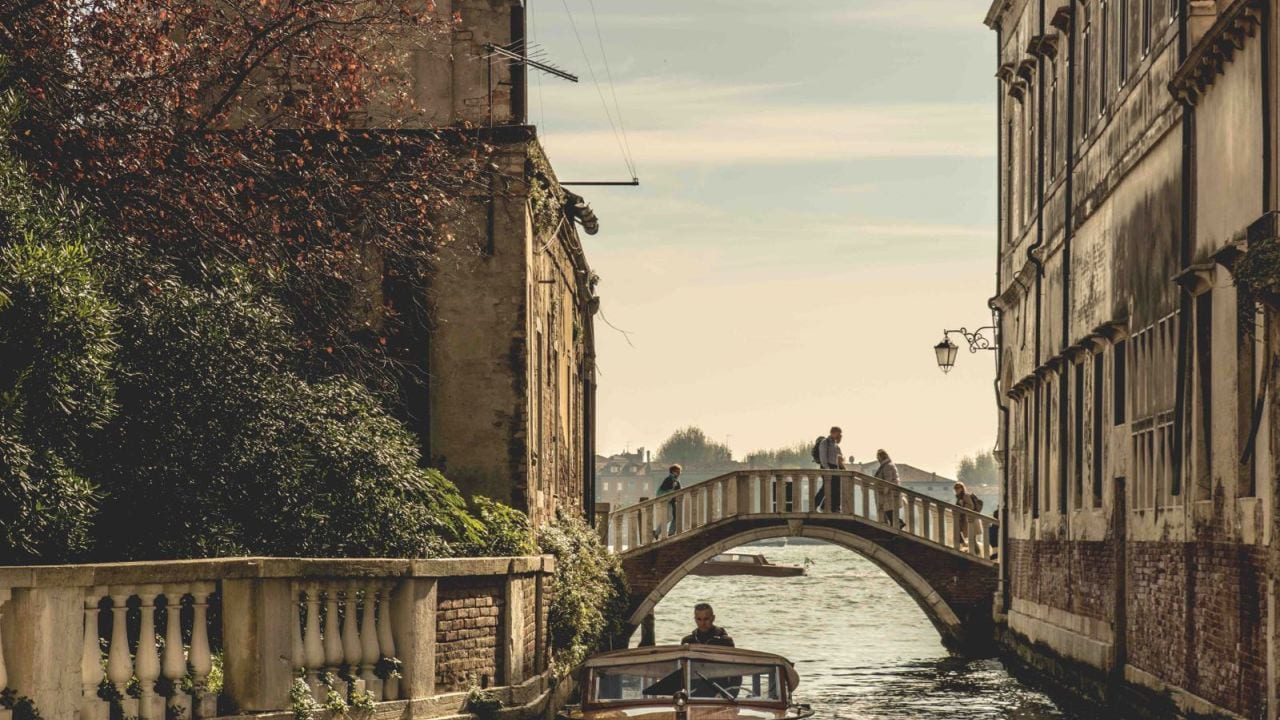
February 14, 2020
Literary Venice: 6 Beautiful Descriptions of Venice in Literature
Oh, Venice! Its name alone is enough to conjure images of a time gone by. But why stop...
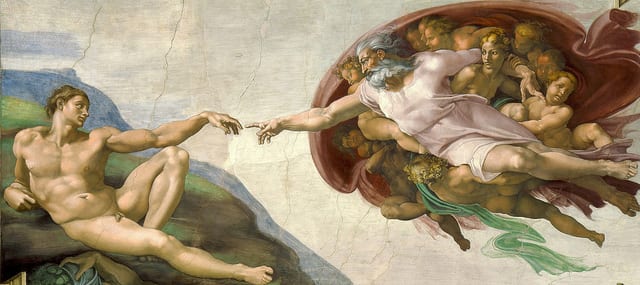
July 08, 2015
8 Interesting Facts about Michelangelo that Might Surprise You
Michelangelo Buonarroti is one of the greatest artists of all time. During his prodigious career he...
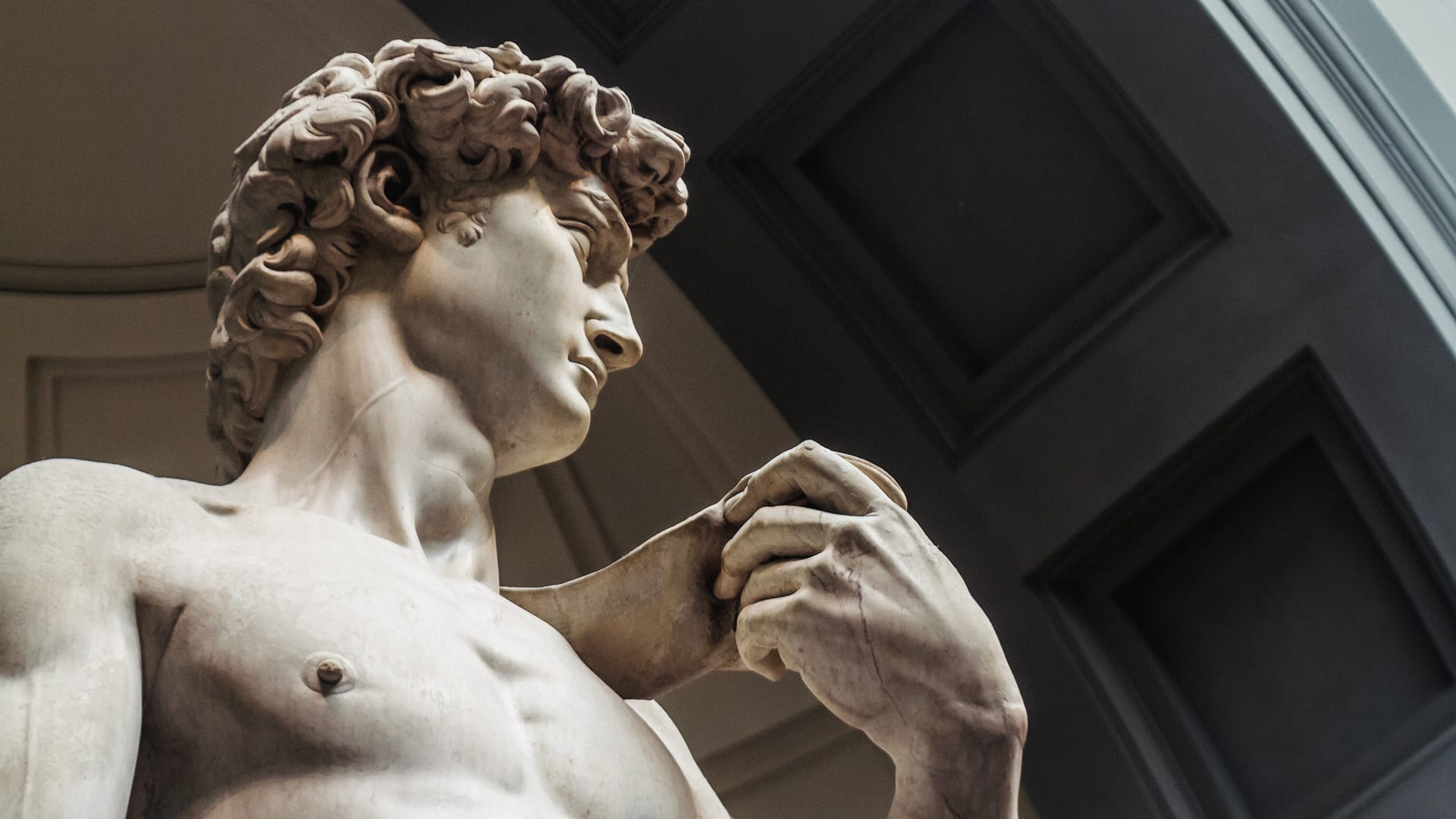
April 15, 2020
Virtual 360 Tour: Alone with Michelangelo’s David in the Galleria dell’Accademia
Experience Michelangelo’s David as you walk through the Galleria...

February 24, 2020
The Secondhand Origins of Michelangelo’s David
They say there’s nothing new under the sun, that all ideas have been formulated and reformulated...
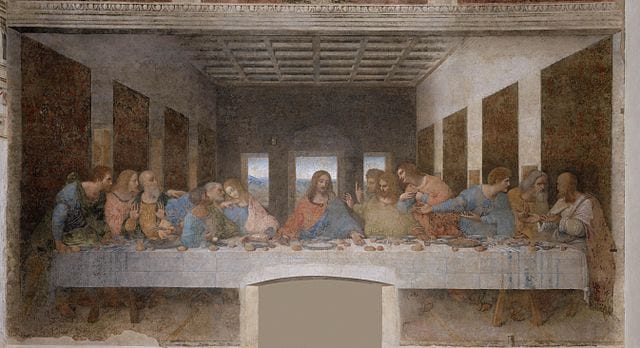
April 12, 2023
The Life of Leonardo Da Vinci: 9 Facts They Didn’t Teach You in School
Painter, writer, inventor, sculptor, musician – Leonardo da Vinci was one of Italy’s...
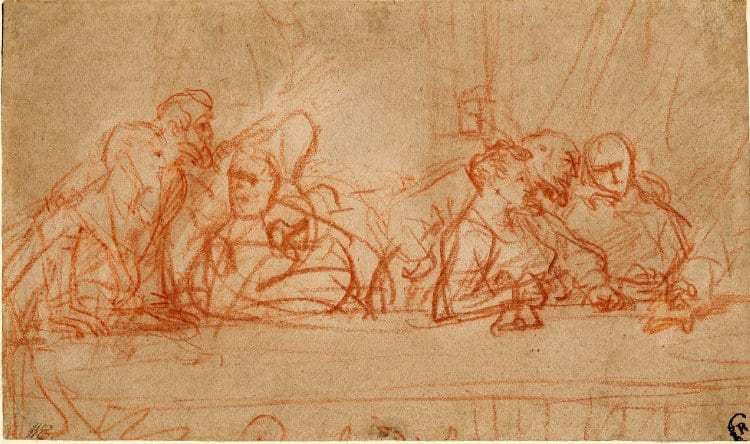
July 30, 2015
8 Fascinating Facts You Didn’t Know About Da Vinci’s Last Supper
One of the most famous works of art in the world, but how much do you know about...
Stay up to date with travel tips, local insights and all things Italy on our social channels!
Subscribe to our Newsletter
Get curated Italy travel tips delivered to your inbox!
Your browser is out-of-date!
Update your browser to view this website correctly. Update my browser now

Loved the Book? Go There, Literally, with a Literary Tour
By Charis Atlas Heelan
Literature has long inspired people to travel. Literary tours probably started in the fifth century B.C. with the Greek writer and historian Herodotus in his seminal work The Histories , which features magical accounts of ancient Egypt during the Ptolemaic period. It inspired thousands of Greek and later Roman citizens with means, to visit the shores of the Nile River in search of great wonders.
In the 19th-century, it was the works of the great English literary scholars like Keats, Byron and Shelley that captivated English-speaking audiences everywhere and brought them in droves to Italy, where the authors were holding court. That tradition continued into the early 20th-century with great novelists like E.M. Forster and his breathtaking accounts of life in Italy as seen through the eyes of British travelers in books like Where Angels Fear to Tread and Room with a View . No trip to Lake Como would be complete without reading the first, nor would Florence seem as romantic without the latter.
Ernest Hemingway, a master storyteller, has long moved people to travel to far-away places and experience cultures from a local perspective. Although many of his novels are regarded as chauvinistic and even brutal, no one can deny the impact they have had on travel to destinations such as Cuba ( The Old Man and The Sea ), Spain ( The Sun Also Rises and For Whom the Bell Tolls ) and Paris ( A Moveable Feast ).
Although travel may have changed, inspiration for doing so has not and contemporary literature continues to attract visitors to undertake almost pilgrimage-like tours to remote settings of their favorite novel or poetry. Often they come to try and invoke the spirit of the book or author, to feel inspired to perhaps write their own work of great-fiction or to visit the home or grave of a beloved dead writer.
The resurgence of literary travel is currently reaching a peak, especially since the publication and almost deification of Dan Brown's The Da Vinci Code . A book that combines threads of fact and history with artistic license and pure fiction to create a thrilling mystery, has led to a new fad in tourism, especially in Paris, where a majority of the book is set.
The Da Vinci Code has spawned an entirely novel (pardon the pun) tourist attraction in the form of tours that explore some of the main sites and mysteries of the novel. One of my personal favorites is "The Da Vinci Code" package at the 17th-century Chateau de Villette ( www.frenchvacation.com ) located some 35 miles outside Paris, near Versailles. Conducted by the owner of the magnificent property, the $4,500 per person price tag includes five-nights in the chateau's deluxe rooms, meals, ground transportation, and guided tours. Or for a mere $2,500 more, you can get the add-on package which includes two nights at the Ritz Hotel Paris and visits to all the locations mentioned in the book. You may be surprised to know that these packages are well patronized.
These Da Vinci Code tours are so popular that they are even turning up on websites like the Craigslist in Paris. " The Secrets of the Davinci Code Tour " is a two-hour tour that begins with a champagne brunch at the Cafe Marley, followed by a visit to the Louvre and Saint Sulpice to discover the Secrets of Dan Brown's novel. Tours are led by American architects and art historians, now living in Paris (although based on the spelling mistakes in their ad, I am a little suspicious of this claim). The rather steep price tag of $127 per person (maximum of five people per tour) includes a map, points of interest brochure, champagne brunch and Louvre admission. Contact +336/2121-1355 ; [email protected] for further information.
Paris Through Expatriate Eyes ( www.paris-expat.com/tours/davinci_code.html ) provides a two and a half hour " Cracking the Da Vinci Code " tour of the Louvre including admission price for $184 per person in small groups of up to four people.
" The Da Vinci Code " is also bringing more independent tourists to the Louvre with the French version of the book even on sale in the Louvre's official bookstore.
The small southern-French town of Rennes-le-Chateau is likewise being inundated with tourists as it is featured in the book and acts as a catalyst for the origin of the mystery. To be fair, this town first gained notoriety when the same mystery and premise for The Da Vinci Code was originally set forth in the 1983 book by Michael Baigent, Holy Blood, Holy Grail .
Not to be outdone by their French cousins, British Tours Ltd ( www.britishtours.com/davincicodetours.html ) has seized on The Da Vinci Code mania with its own version of a Code tour but this time taking in the London locations and factual elements of the book. The three-hour London tour is priced per car or minibus rather than by person and costs range from $328 for a small group (car load) to $850 for a group of ten in a mini-bus.
Brown's prequel to The Da Vinci Code -- Angels and Demons -- is also gaining ground as a tourism initiator as it is set in Rome and select tours are already springing up to meet the demand of avid Brown fans.
Another recent literary phenomenon that has encouraged a new form of travel is the series of Harry Potter books. Although originally conceived as children's titles, the books are read by people of all ages and have inspired tours in the United Kingdom, despite the extremely fictitious nature of most of the locations.
A selection of Harry Potter tours is available through Harry Potter Fan Trips (tel. 800/487-1136 ; www.hpfantrips.com ). All tours include a visit to Oxford to see the filming locations, a special "Great Hall"-style banquet, and a ride on the official train with engine #5972 (used as the official Hogwarts Express in the Harry Potter movies). The seven-day, six-night London and Oxford tour departs on July 31, 2005 and ranges from $1749 to $1,999 per person depending on accommodation standard. Weekend four-day, three night packages are $799 per person. Their "Science in a Wizarding World" package, also departing on January 31, 2005, is priced at $1,799 per person and includes six-nights accommodation in three and four-star hotels, a specialized guide, breakfast daily, two lunches, four dinners, luxury coach transfers, treasure hunt including Harry Potter movie sites, admission to the Tower of London and Christ Church College, virtual reality "Flying on a Broomstick" experience, Herbology and Potions classes, limited edition Alivan's magic wand, and a London Underground pass. Discounts are provided for family groups. Reserve your trip by December 31, 2004, and take $50 off any week-long package or $25 off a weekend package. Airfares to London are additional.
In 1990, it was Peter Mayle's A Year in Provence that stirred masses of literature buffs to journey to the French region in search of the beauty, innocence and possibly even a sneak peak at Mayle's country home. Even today as you travel through the hills of Provence, you will always see tourists with a paperback in their hands, using it like a travel guide. Tour companies are still capitalizing on the book's wide appeal, mentioning it on websites and forming tours that take in particular towns that act as the both the setting and main character of the book.
And in the later 1990's, Tuscany tourism had an enormous boost with the success of Frances Maye's inviting tale of female emancipation and adventure, Under the Tuscan Sun: At Home in Italy . There are a number of interesting and diverse tours available that are cashing in on the popularity of the book, especially among single women.
Escorted Italy Tours (tel. 800/942-3301 ; www.escorteditalytours.com ) has an "Under the Tuscan Sun Cooking Tour" in Cortona, Italy the setting of the book. The package includes six-nights double occupancy at the four-star Hotel San Michele daily breakfast, three hands on cooking lessons, six dinners in local restaurants with local wine, lunch in Siena, wine-tasting, guided tours, entrance fees, excursions and round-trip transfers to Terontola train station. Prices for the 2005 season have not yet been confirmed.
Tuscany Under the Skin ( www.tuscanyundertheskin.com ) has a "Tuscany Discover the Heartland" tour that includes tour guide, transportation, charming hotels and pensiones, all specified meals including wine, farmhouse cooking lesson and lunch, thermal pool and visits to Cortona, Pienza, Siena, San Gimignano and Montepulciano. Priced at $1,484 for land-content only, the tour departs on 29 May, July 3, September 11 and October 16 in 2005. Airfares are additional.
EcoTouring Tuscany ( www.infohub.com/TRAVEL/SIT/sit_pages/14099.html ) has an Under the Tuscan Sun biking tour. For $1,200 per person (or $200 more for a single supplement), you can take a Tuscan adventure that includes six-nights accommodation, daily breakfast, luggage transfers, all biking equipment and some of the most beautiful landscapes that you will ever experience. Tours departs regularly from Florence between April and October.
Travel companies like Novel Explorations ( www.novelexplorations.com ) and Casterbridge Tours ( www.casterbridgetours.com/US/soffer.html ) specialize in literary tours that focus on particular regions as inspiration for great literature throughout the ages. Tours with Novel Explorations start at approximately $1,800 for ten-day experiences in Ireland, Scotland and England, whereas Casterbridge also incorporates modern literature themes (more Harry Potter and Da Vinci Code) in various countries throughout the world.
There are so many other brilliant authors whose works have allowed readers to dream of far away places, that it is impossible to list them all here. Often it is the combination of the perfect geographical location and the richness of the fictitious characters that makes a story seem so real. For those who like to immerse themselves in the places they visit, I recommend a few more writers here as those you should consider for your next trip.
Anything and everything by James A Mitchener including The Covenant (South Africa) Mexico , Chesapeake (Chesapeake Bay), The Source , Iberia (Spain), Hawaii , Alaska and Poland just to name a few. Memoirs of a Geisha by Arthur Golden (Japan), Salman Rushdie's The Jaguar Smiles: A Nicaraguan Journey , Bill Bryson for his extreme whit and insight into so many countries, but especially Australia in In a Sunburned Country and Bruce Chatwin's Songlines , which is an equally indispensable travel companion for a trip down under.
If you are searching for general travel inspiration or would like to enhance your vacation experience from a literary perspective, pick up a copy of American Historical Fiction: An Annotated Guide to Novels for Adults and Young Adults which includes over 3,000 titles indexed by author, title, genre, subject, and most importantly, geographic setting.
Biblio Travel ( www.bibliotravel.com ) is a website that can also provide you with travel insights without actually reading a travel guide. With 1,811 books listed, set in 1,646 locales, you can search by geographical setting, author or genre. A perfect resource for someone looking for a good book to read to get them in the mood for their next travel adventure.
Discuss literary travel on our new Cultural Immersion Message Boards .

- All Regions
- Australia & South Pacific
- Caribbean & Atlantic
- Central & South America
- Middle East & Africa
- North America
- Washington, D.C.
- San Francisco
- New York City
- Los Angeles
- Arts & Culture
- Beach & Water Sports
- Local Experiences
- Food & Drink
- Outdoor & Adventure
- National Parks
- Winter Sports
- Travelers with Disabilities
- Family & Kids
- All Slideshows
- Hotel Deals
- Car Rentals
- Flight Alerts
- Credit Cards & Loyalty Points
- Cruise News
- Entry Requirements & Customs
- Car, Bus, Rail News
- Money & Fees
- Health, Insurance, Security
- Packing & Luggage
- -Arthur Frommer Online
- -Passportable
- Road Trip Guides
- Alaska Made Easy
- Great Vacation Ideas in the U.S.A.
- Best of the Caribbean
- Best of Mexico
- Cruise Inspiration
- Best Places to Go 2024
- Share full article
Advertisement
Supported by
Florence, Then and Now

By Adam Begley
- Nov. 28, 2008
HERE'S what you do first in Florence: Complain about the tourists. It's a time-honored tradition and there's no avoiding it — or them, as they squeeze down the narrow streets. They choke the majestic Piazza Signoria; they overwhelm the Uffizi Gallery — so go ahead and get the grumbling over with. Hordes of them! A year-round blight! Why can't they just stay home! Or, if you're like E. M. Forster's “clever” lady novelist in “A Room With a View,” the one who exclaims in dismay over the bovine “Britisher abroad,” admit that you'd like to administer an exam “and turn back every tourist who couldn't pass it.”
Snobbery is part of the sophisticated traveler's baggage — that hasn't changed at all in the 100 years since Forster, in his charming novel, skewered the supercilious “good taste” of those who look down on the “ill-bred people whom one does meet abroad.” Nowadays, when everyone in the ill-bred crowd is snapping photos of the Duomo with a cellphone, or swarming the Ponte Vecchio, plastic water bottle in hand, the urge to override touristic self-loathing by claiming for oneself a spurious superiority is pretty much irresistible; Forster, were he still around, would poke fun at that snobbish impulse with puckish glee. (But don't let that stop you from grousing about the sheer number of bodies blocking the view of the Arno.)
The next thing to do in Florence, according to Forster, is throw away your guidebook. Chapter II of “A Room With a View” is called “In Santa Croce With No Baedeker,” and it's a gently comic interlude every honest visitor to that great Franciscan basilica will recognize as a mocking portrait of himself. Or herself, in the case of our young heroine, Lucy Honeychurch, who winds up alone in the vast interior of Santa Croce without her “Handbook to Northern Italy.”
On the way in she noted “the black-and-white facade of surpassing ugliness” (the marble was added in the 19th century — paid for by an Englishman, by the way); now she's rattling around in the vast nave, wondering which of all the tombs was “the one that was really beautiful,” the one most praised by Ruskin. With no cultural authority to tell her what to think, she thinks for herself: “Of course it must be a wonderful building. But how like a barn! And how very cold!” And then, just like that, her mood changes: “the pernicious charm of Italy worked on her, and, instead of acquiring information, she began to be happy.” We all want to be happy tourists, so here's the question: Is Forster's early 20th-century advice — toss the guidebook aside and let the pernicious Florentine charm seduce you — still viable early in the 21st?
ENJOYING “A Room With a View” is easy. A love story that begins and ends in Florence, with complications in England sandwiched in between, it's short, cheerful and delightfully sly. Besides, there are two excellent and generally faithful film adaptations, the classic 1986 Merchant-Ivory production starring Helena Bonham Carter and Daniel Day-Lewis and a PBS version released just this year with enticing shots of Florence and a weird, unwarranted twist at the end. Once Lucy Honeychurch and George Emerson have kissed in a field of violets in the hills above the city (near Fiesole, about which more later), you know (spoiler alert) you're going to hear wedding bells at the end, no matter how many plot twists the crafty author engineers.
Enjoying Florence — a hard, forbidding city (“a city of endurance,” Mary McCarthy called it, “a city of stone”), handsome but not pretty, a challenge even if you could siphon off the tourists and replace them with picturesque Italians energetically engaged in producing local color — enjoying Florence takes more time and more effort. But if you have with you your copy of “A Room With a View,” you'll find it easier to get along. Forster's supple, forgiving irony, his ability to satirize lovingly, combined with his firm but regretful insistence on not confusing art and life, is exactly what you need if you plan to share this intensely urban town with tens of thousands of sightseers for the five or six days it will take you to do just like them and see the sights.
Forster reminds us that though Florence is a capital of art (is it ever!), it's not just an overcrowded museum. When Lucy leans out of her window in the Pensione Bertolini and gazes out across the Arno at the marble churches on the hill opposite, and watches with dreamy curiosity as the world trips by, the author notes approvingly, with his usual mild irony, “Over such trivialities as these many a valuable hour may slip away, and the traveler who has gone to Italy to study the tactile values of Giotto, or the corruption of the Papacy, may return remembering nothing but the blue sky and the men and women who live under it.” He's not suggesting that you ignore Giotto or the magnificence of the city's turbulent history, but that the hours spent soaking up the dazzling Florentine sunshine with no cultural agenda may be valuable after all.
When Forster himself first came to Florence in October of 1901, he stayed as Lucy did in a pensione on the Lungarno delle Grazie, with a view over the Arno to the Basilica di San Miniato al Monte and the dark hills beyond. He was on a grand tour, traveling with his mother, and was a dutiful sightseer. He wrote to a friend back home, “the orthodox Baedeker-bestarred Italy — which is all I have yet seen — delights me so much that I can well afford to leave Italian Italy for another time.” He was back the following year, at the same pensione, and by the time he'd finished “A Room With a View,” he'd struck a happy balance.
In and around the Basilica di Santa Croce is everything that's delightful and appalling about Florence today. The neo-Gothic facade is still ugly, the long square in front of it dusty, bland, pigeon-infested and lousy with tourists. The interior is still cavernous, austere and chilly, impressive but somehow dispiriting. Even if you've ditched your guidebook, you're reminded at every step of the city's vast cultural riches: here are the tombs of Michelangelo and Galileo and Lorenzo Ghiberti, whose bronze baptistery doors opposite the Duomo were so perfect, according to Michelangelo, they could have been the gates of paradise; here are the memorials to Dante and Machiavelli. Crowds are waiting to get into the small, high-ceilinged chapels to the right of the high altar — that's where you can admire the tactile values of Giotto, whose early 14th-century frescoes grace the walls. Just outside the basilica in the main cloister is the Pazzi Chapel, a perfectly proportioned Renaissance gem designed by the great Florentine architect Filippo Brunelleschi (who gave the Duomo its dome). The chapel, its white walls decorated with glazed terra-cotta medallions by Luca della Robbia (one of young Lucy's favorite artists), looks best when it's empty, filled to its noble height with nothing but chalky light from the lantern and the oculi in the dome. In other words, if a tour guide and his flock are in there, wait till they've gone.
The nature of those tours has changed dramatically since Forster's day. In 1901 — and until very recently, in fact — the tour guide pronounced on art and architecture in a booming or piercing voice, mostly in English but possibly also in German or French, while his flock huddled close to catch the echoing words of wisdom. In “A Room With a View,” Forster had fun with the solemn pronouncements of the Rev. Cuthbert Eager, who steered an “earnest congregation” around Santa Croce, lecturing all the while on the fervor of medievalism (“Observe how Giotto is ... untroubled by the snares of anatomy and perspective”). Today, technology has shushed the tour guide: he or she whispers into a microphone, which broadcasts the lecture soundlessly, piping the flow of factoids into the earphones of the audience, who can now stray a little (and there are more languages represented: Spanish, Greek, Polish, Russian). Some familiar props remain — the retractable antenna with a ribbon tied at the tip, a rallying sign for the group as it migrates from one artistic treasure to the next — but the new quiet is disconcerting, as though these clumps of tourists with headphones and wireless receivers hung around their necks were part of some sinister silent conspiracy.
IF you stroll a few dozen yards past the Pazzi Chapel, you'll find yourself in a second cloister, also designed by Brunelleschi, in 1446, the last year of his life. It's a place of great beauty and calm, usually deserted, and you don't need to know a thing about it to fall in love. The simple, elegant two-story cloister with its slender columns shelters you from the rigors and confusions of Florence and gives you instead the tranquil harmony of the Renaissance without pomp or grandeur, washed by bright Tuscan sun. I like to imagine, though Forster doesn't suggest it, that Lucy loitered here without her Baedeker, and that's why she began to be happy. At the very least, a quiet moment in the cloisters will give you strength to confront the multitudes and the immortal works of art remaining on your list.
And so will loitering over lunch. And dinner. One eats very well in Florence, and in general the simpler the restaurant, the better the food. If you can visit one church and one museum before lunch and one more church or another museum after lunch (whatever you do, don't miss the wealth of paintings piled higgledy-piggledy in the Palatine Gallery of the Palazzo Pitti), and then take a nap (Tuscan wine is cheap and abundant), and then stroll to dinner, perhaps along the Via de' Tornabuoni, under the looming, illuminated facades of great, stern palazzos, and stroll some more after dinner when the crowds have thinned and Florence seems gentler and the multicolor Duomo seems less garish but just as huge and astonishing — you'll find that after a few days of this routine, all your complaints will be forgotten, replaced with amazement and gratitude.
Unless of course you stray into the Piazza Signoria, where the replica of Michelangelo's giant David attracts a sizable contingent of art lovers with camera phones night and day. This is where Lucy wanders one evening, unaccompanied:
“ ‘Nothing ever happens to me,' she reflected, as she entered the Piazza Signoria and looked nonchalantly at its marvels, now fairly familiar to her. The great square was in shadow; the sunshine had come too late to strike it. Neptune was already unsubstantial in the twilight, half god, half ghost, and his fountain plashed dreamily to the men and satyrs who idled together on its marge. The Loggia showed as the triple entrance of a cave, wherein dwelt many a deity, shadowy but immortal, looking forth upon the arrivals and departures of mankind. It was the hour of unreality — the hour, that is, when unfamiliar things are real. An older person at such an hour and in such a place might think that sufficient was happening to him, and rest content. Lucy desired more.”
And then something does happen to her: two Italians quarrel, one stabs the other in the chest, and Lucy, who sees the blood come trickling out of the fatally wounded man's mouth, swoons — into the arms of George Emerson, as luck would have it.
Nothing so dramatic is likely to occur to the 21st-century visitor. But if it does, head for Fiesole, the little hill town no more than a few miles from the Piazza Signoria. Along with the far reaches of the Boboli Gardens, this is the city's escape hatch, a chance to breathe deeply and see some greenery, plant life being notably absent from the historic center. Forster sends his contingent to Fiesole by horse and carriage (it's nearby that Lucy and George first kiss); now it's a 15-minute ride on a boxy orange municipal bus. But once you've arrived you realize that the chief virtue of this modest town, aside from the fresh air, is the panoramic view of the Arno Valley and the extraordinary, maddening city you've just left, its Duomo vast and proud even at this distance. And the wisdom of the structure of “A Room With a View” is suddenly as clear as the bright Tuscan sky: you will return to Florence, and next time it will be a honeymoon.
BEAUTY, STONES AND HANGING HAMS
GETTING THERE
There are no nonstop flights from New York to Florence. A number of airlines offer daily flights with connections through various European capitals; of those, the easiest is Alitalia, which offers several daily flights via Rome for about $650. The small Florence airport is only a few miles from the city; a bus service runs to the train station in the center of town and there are taxis, too. Once you have reached Florence, everything is within easy walking distance except Fiesole, which can be reached by taxi or bus.
WHERE TO STAY
If you are staying in the center of Florence, what you want is an oasis, and despite the tacky name, Hotel Monna Lisa (Borgo Pinti, 27; 39-055-2479751; www.hotelmonnalisaflorence.com) provides exactly that. A converted 14th-century palazzo five minutes by foot from the Duomo, it's handsomely decorated and blessedly calm. A double room will currently cost you 125 euros ($160 at $1.28 to the euro).
If you must have a room with a view, go to Fiesole. Pensione Bencistà (Via Benedetto da Maiano, 4; 39-055-59163; www.bencista.com) is shambolic and charming — and affordable, at about 185 euros for a double room with breakfast and dinner included.
Also in Fiesole is the Villa San Michele (Via Doccia, 4, Fiesole; 39-055-59451; www.villasanmichele.com), which will bankrupt you — it's around 850 euros for a double room, but you will be coddled and cosseted in a gorgeous setting.
WHERE TO EAT
Meals are important in Florence, not just because the food is so good, but also because the rest of the time you're on your feet. Lunch for two, with wine of course, should cost you about 60 euros; dinner, with more wine, about 100 euros.
For lunch, especially Sunday lunch, Il Latini (Via de Palchetti, 6/r; 39-055-210916; www.illatini.com) is a must. Don't bother with a menu (the waiters don't like to give them out, and anyway they know better than you what's good). Help yourself to the big bottle of red wine you'll find at your table. Admire the hundreds of hams hanging overhead. Eat!
Quiet, relatively tourist-free, pleasantly traditional and equally delicious is Del Fagioli (Corso Tintori, 47/r; 39-055-244285), just a few blocks from Santa Croce.
If you want a little atmosphere at night and you're willing to pay a premium for the buzz and the funky décor, try Trattoria Garga (Via del Moro, 48/r; 39-055-2398898; www.garga.it).
And if you're in Fiesole at night and don't want to engage in the enforced sociability of the pensione, Trattoria i' Polpa (Piazza Mino, 21/22; 39-055-59485) is cozy and friendly and inexpensive.
WHAT TO READ
Fifty years after the publication of “A Room With a View,” E. M. Forster wrote a short essay in The New York Times Book Review called “A View Without a Room,” in which he speculated on the fate of the characters in his novel — not quite dessert, more like a tasty petit four. It has been printed as an afterward in the Penguin Modern Classics edition of “A Room With a View.”
P. N. Furbank's massive two-volume biography of Forster was first published three decades ago; now available in a one-volume Faber paperback, it's still the best account of a long, remarkable life.
If you want a critic's perspective on “A Room With a View,” see the chapter on it in Lionel Trilling's excellent “E. M. Forster: A Study,” first published in 1943 but available in paperback from New Directions.
ADAM BEGLEY is the books editor of The New York Observer.
THE 10 BEST Province of Florence Literary, Art & Music Tours
Literary, art & music tours in province of florence.
- Wine Tours & Tastings
- Cultural Tours
- Historical & Heritage Tours
- Literary, Art & Music Tours
- Up to 1 hour
- 1 to 4 hours
- 4 hours to 1 day
- 5.0 of 5 bubbles
- 4.0 of 5 bubbles & up
- 3.0 of 5 bubbles & up
- 2.0 of 5 bubbles & up
- Chinese (Simplified)
- Chinese (Traditional)
- Likely to Sell Out
- Special Offers

- The ranking of tours, activities, and experiences available on Tripadvisor is determined by several factors including the revenue generated by Tripadvisor from these bookings, the frequency of user clicks, and the volume and quality of customer reviews. Occasionally, newly listed offerings may be prioritized and appear higher in the list. The specific placement of these new listings may vary.


331. Private Tour of Florence and Uffizi Gallery

332. Michelangelo's David Tour with Skip-the Line Tickets and Accademia Gallery Visit

333. Livorno Port ShorExcursion: Florence and Pisa The Best

334. Duomo Complex & Accademia Gallery Tour with Cupola Entry Tickets

335. Kids & Families Michelangelo Florence Tour w/ Skip-the-Line Accademia Gallery

336. Private Best of Florence With Uffizi Gallery

337. Duomo Complex & Uffizi Gallery Tour with Cupola Entry Tickets

338. Best of Florence tour with Galleria degli Uffizi visit

339. Florence Full Day Guided Tour: Skip-the-line access to the Uffizi & David

340. Florence Accademia Gallery and the Hidden Stories of David Tour

341. Florence Accademia Gallery and David Skip-the-Line Guided Tour with Hotel Pickup

342. 2-Hours Walking Tour in Florence

343. Walking across the best of Florence: art, architecture and a sweet pause

344. Florence Card and Exclusive Private Tour on Michelangelo Genius

345. Livorno Port Shore Excursion: Florence and Pisa

346. Professional Photographer and Driver Florence Tour

347. Michelangelo in August - The Accademia Gallery

348. Florence: Ultimate Uffizi Gallery Tour

349. 4-Hour Private Walking Tour in Florence

350. Florence Antiquarian Houses Private Art Tour

351. Santa Maria Novella Private Tour

352. Florence and Pisa from Livorno Cruise Port Shore Excursion

353. Professional Photographer and Driver Florence Tour

354. The passion of the princes of Florence: marble and precious stones

355. Skip the Line Bargello Palace and Museum Private Guided Tour

356. Climb up the secret tower: see Florence from the top!

357. Florence Duomo Skip the Line Exclusive Guided Tour

358. Private Uffizi's Gallery tour

359. Private Florence Highlights Guided Tour including Ponte Vecchio and Santa Croce

360. Instagrammable Florence: a guided tour of the highest photogenic places to post
You are using an outdated browser. Please upgrade your browser to improve your experience.
Fall in love with Florence!
Visit Florence Newsletter
Ask the Tuscany Experts on our Forum
- Book your Hotel
- Rentals by Owners
- Museums & Tours
Get the lowest rate for your Hotel in Florence through Booking.com
Get the best deal direct from the owners on FlorenceAccommodation.com
Book your unique Florentine Experience
Book your Tour
Book your Tickets ahead & Skip the line!
Buy Museum Tickets
- Itineraries
- Leonardo da Vinci Florence Highlights
Leonardo da Vinci in Florence. Traces of the Genius across the city & province
Leonardo da Vinci left a legacy bigger than life and we celebrated it all on the 500 year anniversary of his death, May 2, 2019.
And Florence loves to boast that this patrimony of information started right here in the city, in within its very walls!
That is partially true.
It actually started in a small town, Anchiano, a locality situated just a few kilometers from Vinci , where tradition has placed Leonardo's birthplace on April 15, 1452. However, since Vinci is within the province of Florence, perhaps we can allow that they are right , and say it all started right here in Florence.
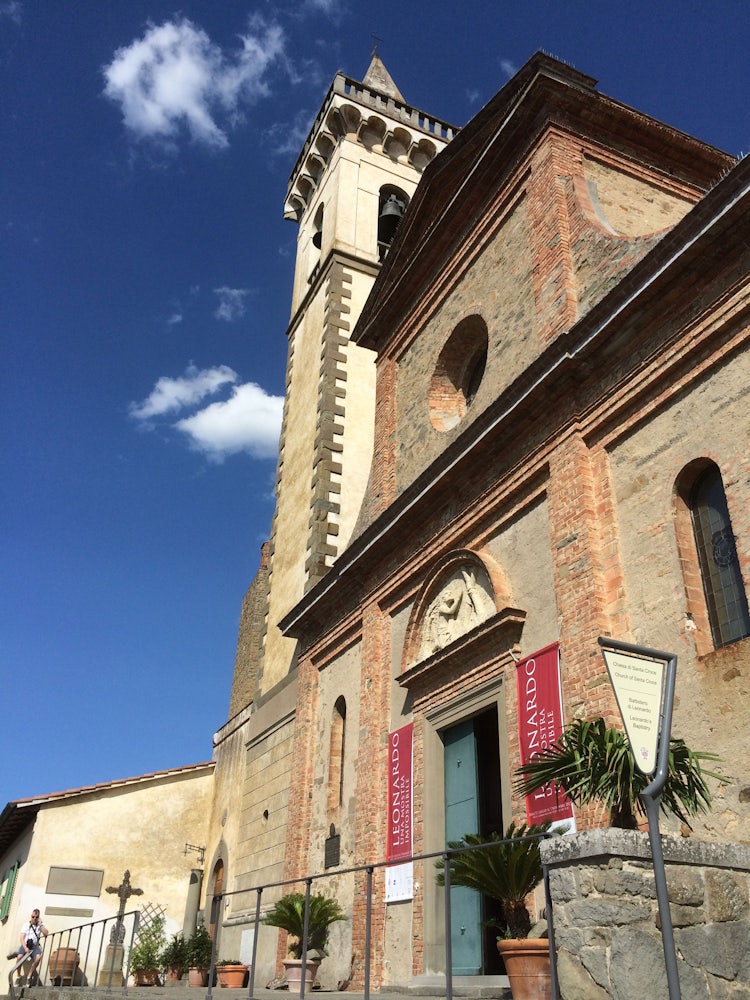
Once upon a time in Vinci
Vinci not only hosts a museum which brings to life some of his more famous designs and inventions but also hosts a library which was officially inaugurated in 1928 - but its origins reach as far back as 1883. The library has facsimiles of all the manuscripts and drawings ever made by Leonardo da Vinci, as well as all of his literary works. In addition, it contains more than seven thousand monographs in many languages, cinematographic films, posters, maps, photos, slides, x-rays of paintings, and writings by contemporary authors which all make reference to Leonardo.
A visit to this quaint little town could include a stop at all three of these locations (birthplace, museum & library) ... but if you wanted to really touch base with the life of Leonardo, a fun adventure could include:
- Visit the Chiesa di Santa Croce , which still conserves the baptismal font where Leonard was baptized
- Stroll about the Piazza Leonardo da Vinci , where it is rumored that one of Leonardo's half-brothers managed a tavern and butcher shop
- Walk past the building that belonged to the Da Vinci family until 1555 near Piazza Guazzesi
- Hike out to the panoramic hills of Montalbano to enjoy the views that once inspired Leonardo
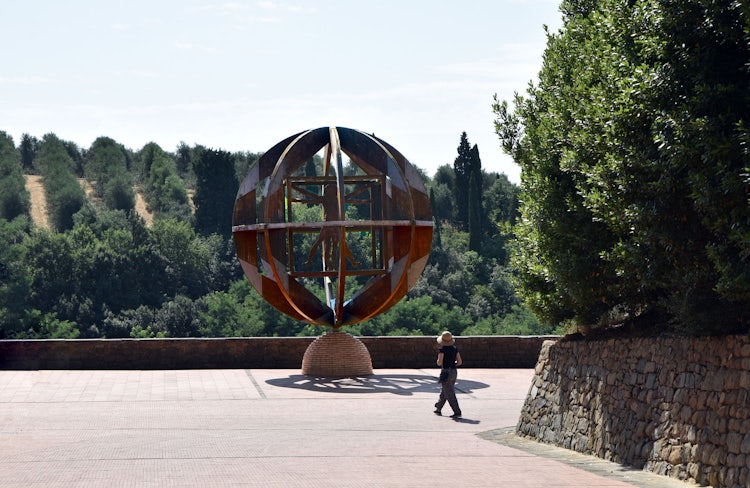
Life in Florence
Our adventure is really based in Florence, the city center, where we will highlight some of the places that are closely associated with Leonardo during the periods of time he resided or worked for the city.
1. Our first point of interest in the city center is now known as the Bargello Museum , where his father Ser Piero worked as a notary as early as 1469, and at that time it was called the Palazzo del Podesta.
2. It was around 1469-1470 when his father apprenticed his son as a garzone in the bottega of Andrea del Verrocchio (Via dell'Agnolo/Via de' Macci) . He remained in the workshop for the next 7 years practicing with Verocchio, one of the leading Florentine painters and sculptors of his day.
3. We can document that on August 5, 1473, Leonardo dated his first artwork in pen and ink , which consists of a landscape with a river. As of 2018, there is a room dedicated to the work of Leonardo in the Uffizi Gallery including other important pieces by the artist.
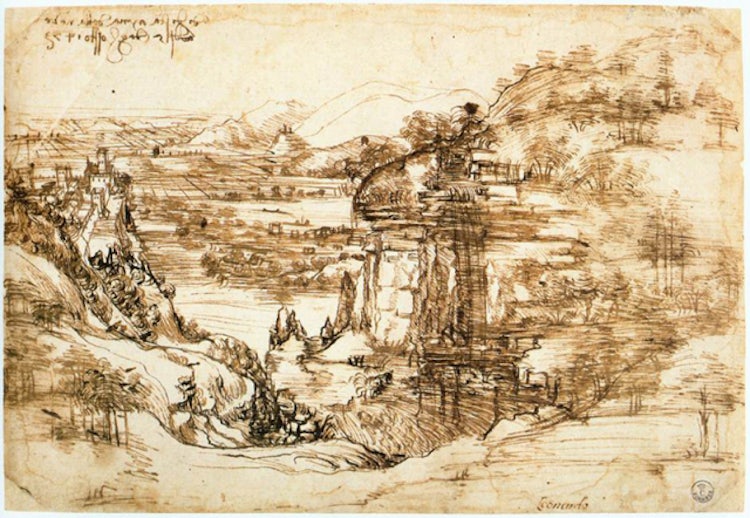
The Diversity of Leonardo's Legacy
4. Another specific date that shows up on the Leonardo timeline in Florence, is December 29, 1479. One of the leaders of the "conspiracy of the Pazzi", Bernardo di Bandini Baroncelli (the murderer of Giuliano de 'Medici), was immortalized in death by a drawing completed by Leonardo, which many say confirms a link between Leonardo and the de' Medici family .
Perhaps one of the most intriguing aspects of Leonardo’s legacy is the diversity of his areas of interest. In fact, there are studies which show that the Da Vinci Code sheets also include military advice and engineering applications most likely created specifically for Lorenzo il Magnifico and the Medici family during this period.
5. Following documented proof of his stay in Florence, we hear from “ Anonymous Gaddiano ”, who left books with notes on the works of Italian artists, mainly those active in Florence. He speaks of Leonardo da Vinci living with the Medici and working in the Garden of San Marco in Florence in the year 1480.
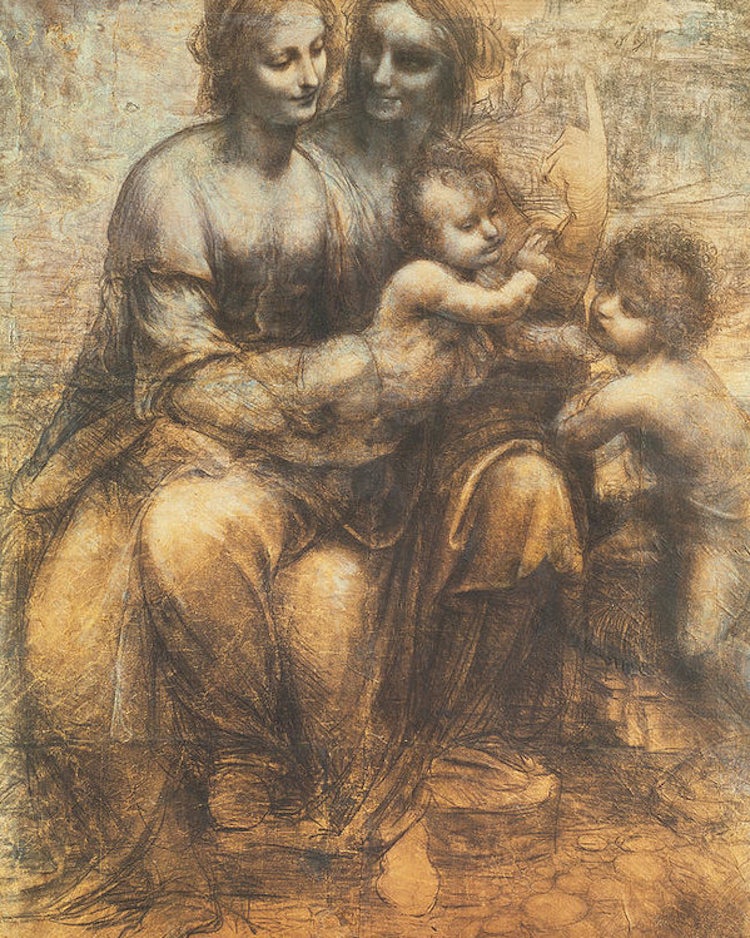
6. We know that he left Florence to work in Milan and various other places until the 1500s but he did return to Florence. It appears that he was a guest of the monks at the monastery of Santissima Annunziata and it is here he created the cartoon drawing of The Virgin and Child with St Anne and St John the Baptist , a drawing which is now located in the National Gallery of London.
Even though the view cannot be appreciated from within the city walls, one of Leonardo’s best-known pieces, executed around the year 1504, was painted when he was in the province of Florence. For those looking to do a road trip into Chianti, follow this itinerary and you can find the location that supposedly inspired the background to the Monna Lisa. However, new studies suggest that it is Castello Vicchiomaggio , now a prominent winery and Tuscan accommodation, was the actual base where he resided while he painted this piece.

Let's return to explore the hot spots within the city walls:
7. He left Florence once more to travel Italy but returned in March of 1503, when Pier Soderini gave him the task of decorating one of the great walls of the new Salone dei Cinquecento in Palazzo Vecchio. This was a work which would be monumental in size and very ambitious depicting scenes of the "Battle of Anghiari".
On the occasion of the 500 year anniversary in 2019, Palazzo Vecchio has prepared a special itinerary which centers around the lost painting by Leonardo da Vinci. It will take guests through the various points of interest in the palazzo regarding Leonardo and this painting.
The various paintings in the hall were to celebrate the concept of " republican libertas " against enemies and tyrants. Each artist was given a different battle. Leonardo was to represent the clash between the Florentine and Milanese armies on June 29, 1440, known as the Battle of Anghiari. On the opposite wall would have been the work of his rival Michelangelo Buonarroti, with the Battle of Cascina (July 29, 1364, against the Pisans).

8. In 1504 Leonardo participated in a committee which was formed to relocate Michelangelo's statue of David . Since the idea of placing 6 tons of marble on the rooftop of the cathedral was rather impractical, the committee decided to place the David at the entrance of the Palazzo dei Priori.
It was at this time that the rivalry between the two great artists showed some of its true colors: Leonardo commented that the nude statue needed some covering up – often suggested to be a symbolic castration of his rival.
Not Just an Artist, but also an inventor
This next "adventure" falls in the region of Tuscany, not in the city of Florence, the plans were commissioned from Florence , so we decided to throw it into the mix.
9. Leonardo da Vinci had visualized and designed many projects involving the Arno, searching for ways that Florence could have its own seaport. Finally, in July 1504, it seemed that he would have the opportunity to make this pipe dream come true when Machiavelli and the Republic gave him a complex hydraulic-military project.
The objective was to build a dam to divert the Arno in order to finally put to rest the rebellious town of Pisa and to conquer their very own seaport. Unfortunately for Leonardo, the contractor who was supposed to be following his designs took one too many shortcuts, compound that with extremely bad weather, and the project was a disaster.
If they had succeeded, da Vinci and Machiavelli would have transformed Florence into a major world power!
10. One of the last documented activities we have of Leonardo da Vinci in Florence and Tuscany is actually just up the hill from Florence in the town of Fiesole . Leonardo and his assistant Tommaso Masini set out to prove that man was capable of flight. In the Codex on the Flight of Birds , Leonardo makes note that Massini was the pilot of the machine. But it appears many of the details can not be confirmed and we are left with anecdotes which only "suggest" that this might have been the first flight by man, ... and that poor Tommaso suffered various broken bones in the first landing...so also the first flight accident as well.

These are just a few of the stops you can make while visiting Florence which will give you a look at Leonardo da Vinci - and if you want to explore more about the Da Vinci Code, we suggest you make some time to visit the Leonardo da Vinci Museum in Florence with examples of some of his more famous designs.
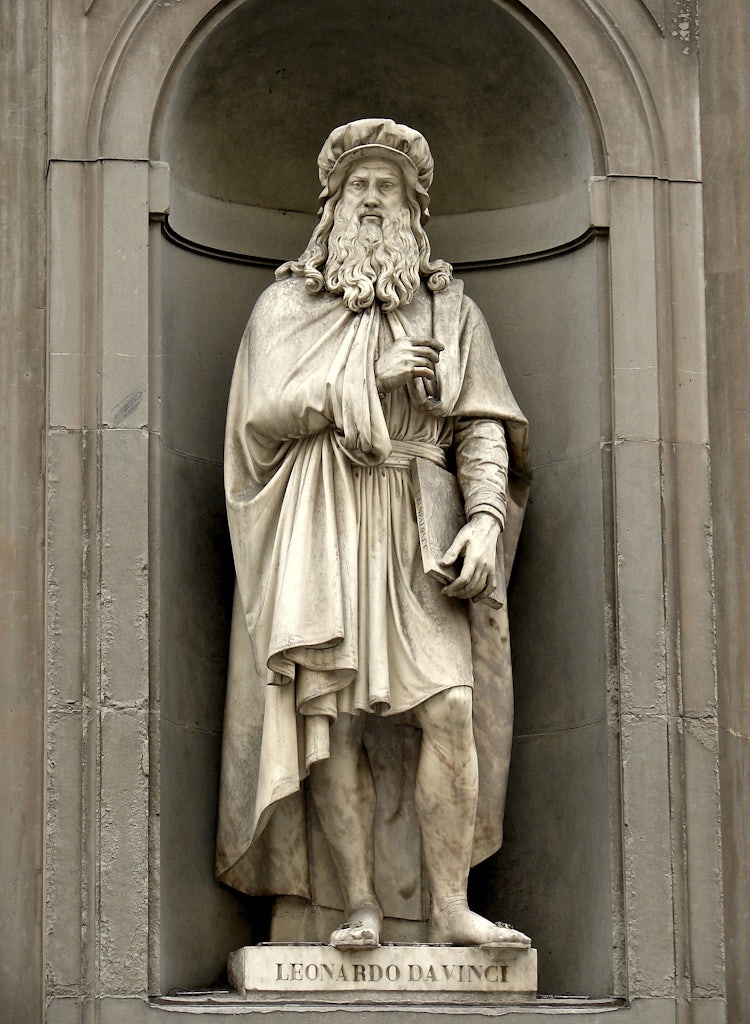
Related Sections
- Itineraries in Florence
You Might Also Like
The best 8 day trips from florence, florence city walls, last suppers in florence, walking itineraries in florence, 2 days in florence, following michelangelo's footsteps, top experiences in florence.
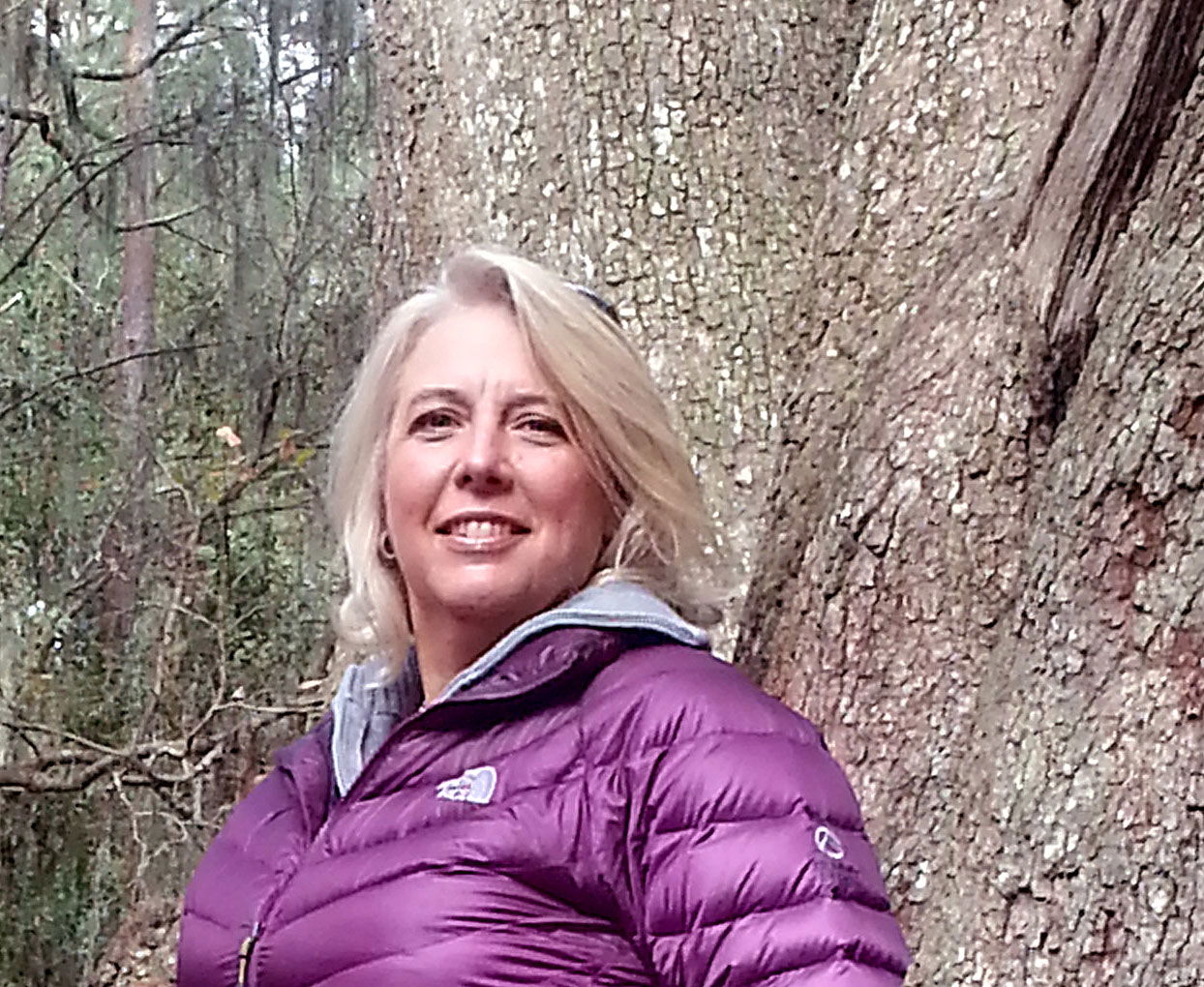
Author: Donna Scharnagl
It has been more than 25 years since I took my first steps in Italy and I still haven’t found a good reason to leave. Between the food, the culture, the history, the art, the landscapes … did I mention the food? I have become a lifelong student. It didn't take long to learn that Italians all have stories that long to be told; stories that paint a picture of how hard work produces character, how life is made of ups and downs and how good it feels to laugh.
You'll love reading about...

Discover the 8 best day trips from Florence in...
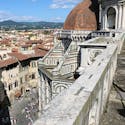
The antique city walls of Florence are just one...
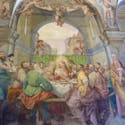
An urban and art history itinerary to discover...
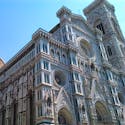
Plan your day around the main tourist...

What to see in Florence in just 2 days? These are our suggestions...
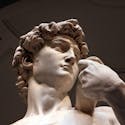
An interesting itinerary through the museums of...
Questions? The right place to ask is our Forum *
* Questions posted on Comments above will no longer receive replies: please ask on our Forum !
Our Travel Guides
TRAVEL GUIDES
Popular cities, explore by region, featured guide.

Japan Travel Guide
Destinations.

A Creative’s Guide to Thailand
Creative resources, photography, videography, art & design.

7 Tips to Spice up Your Photography Using Geometry
GET INVOLVED
EXPERIENCES

#PPImagineAZ Enter to Win a trip to Arizona!
The journal, get inspired, sustainability.

How to Be a More Responsible Traveler in 2021
Europe , explore , italy , resources - creative , travel stories, exploring elena ferrante’s italy: a literary tour of naples.

- Published October 27, 2020
Despite its fascinating history, stunning seaside, and incredible cuisine, Naples has often been cast aside for Italy’s more tourist-friendly destinations like Rome, Milan, and Florence. Enter Elena Ferrante: an Italian novelist whose honest, gritty depiction of Naples has drawn travelers’ attention to the city — and inspired readers from around the world to tour Naples with characters in mind.
Elena Ferrante’s “Neapolitan Quartet” follows the relationship between two friends, Elena (Lenù) Greco and Lila Cerullo, throughout the course of their lives. First published in Italy in 2011, My Brilliant Friend resonated with readers in Italy and beyond. In 2018, HBO released a limited series adaptation of Ferrante’s quartet. The Italian production received high praise for its gripping portrayal of Lenù and Lila’s complex friendship — and its alluring scenes of Naples’s bustling city streets, coastal drives, and nearby islands. The second season premiered this spring and the series has been picked up for season three.
The Neapolitan Quartet has inspired what author and historian Danielle Oteri calls “Ferrante Fever.” For superfans and newcomers to the world of My Brilliant Friend , here’s how to take an Elena Ferrante-inspired tour of Naples:
Touring Elena Ferrante’s Naples
In My Brilliant Friend and the rest of the Neapolitan novels, Ferrante does not always name specific locations; but for those who know the city well, Ferrante’s descriptions offer clues. Naples-based documentary-maker and writer Sophia Seymour has been offering her “Looking for Lila” tour based on the Elena Ferrante novels since 2017. She provides us some tips for uncovering Ferrante’s corner of the city:
Rione Luzzatti
True fans will be keen to explore Lila and Lenu’s childhood neighborhood, Rione Luzzatti. Located east of Naples’s center, readers will recognize the tunnel that Lenù and Lila go through to escape to the sea — this spot is likely an underpass at Via Emanuele Gianturco. The main road, or stradone , is Via Taddeo da Sessa; fans will recognize the fascist-era apartments described in the books.
Seymour points out that Ferrante’s novels inspire a particular feeling that goes beyond specific locations: the nostalgia factor. People enjoy the community aspect of Naples that is alive and well in neighborhoods like Rione Luzzatti, where people still frequent local markets, and neighbors all know each other’s names. As a UK expat in Naples, Seymour looks to the locals for advice when curating her Elena Ferrante tours; she also limits her tours to once a week in order to respect local life.
“Ferrante has raised up exactly what kept people away in the past — that grittiness that she deals with such poetry in the book… It’s one of the most beautiful cities in the world; it’s got this crumbling decadence. There is so much beauty and the people are so warm. People come here and their expectations are only bettered,” she says.
Seymour also suggests visiting the Church of the Sacred Family , originally built in the 15th century. Biblioteca Andreoli is also perfect for Ferrante fans: the public library features My Brilliant Friend-themed murals created by the HBO series’ set photographer, Eduardo Castaldo.
A Taste of Tradition
At the intersection of that community feeling and tradition is, of course, food! Seymour says it’s essential to visit a local market. The city’s energy is on full display at the bustling and vibrant O’Buvero market, where mopeds speed past shopkeepers shouting out each other’s names.
Famous for pizza and its tradition of breadmaking, the best way to immerse oneself in the character of Naples is through its flavors! For sweet confections and other baked goods, check out Pasticciello Pasticceria e Rosticceria , located on Via Vesuvio: this local spot is famous for its pagnutielle , a Neapolitan street snack made from eggs, ham, and cheese that the main characters often order in My Brilliant Friend . Seymour also recommends the classic Neapolitan custard-filled treat sfoglliatella .
In the nearby Mercato district lies the perfect lunch spot. Pizzeria Carmnella serves the “Elena Ferrante” pizza, dedicated to the beloved author, featuring classic Neapolitan ingredients: ricotta, ragu, Fior di Latte mozzarella, and fresh basil.
The Chiaia district and Piazza dei Martiri
Next, visit the elegant Chiaia district, a neighborhood with trendy boutiques, expert tailors, and exciting nightlife. There you’ll find the Piazza dei Martiri, one of the city’s most stunning squares and the location of Lila’s shoe shop in the novels. This neighborhood is perfect for shopping — or just window-shopping — at high-end stores like Bergamo and Prada, strolling along the waterfront, or people-watching in the main square.
The contrast between Naples’ poor neighborhoods and the richer areas is sharply displayed in the books. Protagonist Lenù describes the residents of the Chiaia district as “seeming to have breathed another air.” An Elena Ferrante tour through Naples is incomplete without experiencing this juxtaposition first-hand.

Digging into Naples’ History
As tourists flocked to Naples after falling in love with My Brilliant Friend , Ferrante-inspired tours popped up throughout the city. Along with Seymour’s Looking for Lila tours, art historian Danielle Oteri launched “Ferrante Fever” tours to show off her beloved city to newcomers.
She also penned the guidebook, Ferrante Fever: A Naples Travel Guide Inspired by Elena Ferrante’s Neapolitan Novels . With southern Italian roots herself, Oteri says her guidebook aims to help visitors tour the best of Naples, using Elena Ferrante and her work as a jumping off point.
To understand Naples’ storied past, one has to go below the surface — literally. Oteri recommends the Napoli Sotterranea (Naples Underground) tour. Led by young Neapolitans, visitors can explore Greek quarries that date back 5,000 years, the underground aqueduct network created in the Augustan period, bomb shelters used in the Second World War, and the remains of the Roman Theater.
“Once you understand how much is going on literally underneath Naples, you understand the character of the city,” says Oteri.
Seaside Side-Trip: Ischia
The HBO adaption of My Brilliant Friend puts the beautiful volcanic island of Ischia on display. Known for its thermal spas, sandy beaches, and fresh seafood, Ischia is only a 90-minute ferry from Naples. Ischia is a popular holiday destination for Neapolitans and other Europeans, but it is much less touristy than nearby Capri.
Maronti Beach is an important location in the novels and a serene spot for visitors to relax and swim. Walking from the town of Sant’Angelo to the beach offers gorgeous views of Ischia’s coastline and Capri in the distance.
L’Albergo della Regina Isabella , Ischia’s first luxury property, offers “Following in the Footsteps of Elena Ferrante” packages that include a guided tour of the island.
Armchair Travel
Though North Americans are advised against traveling to Italy for the time-being, reading and watching Ferrante’s stories transports readers to southern Italy and provides some major travel inspiration.
Danielle Oteri’s company Feast on History also hopes to make up for the lack of travel this year with virtual Neapolitan experiences. Though currently based in New York City, Oteri’s Neapolitan cousins host Italian cooking classes on Zoom from their country inn just outside Naples. And in January, Oteri will lead a read-along of My Brilliant Friend in its original Italian, for those who want to go deeper into Ferrante’s prose.
After finishing the Neapolitan quartet and the HBO adaption, fans can pick up Ferrante’s other novels, also primarily set in Naples and the surrounding area. The Days of Abandonment is a stunning, rage-filled drama about a woman starting her life over after her husband leaves her. Her most recent novel, released September 2020, The Lying Life of Adults , is about an adolescent girl growing up in Naples.
The Lying Life of Adults has already been picked up for a Netflix TV adaptation . Plus, her 2008 novel The Lost Daughter is also moving to the big screen — Maggie Gyllenhaal is directing this star-studded adaptation featuring Olivia Colman, Dakota Fanning, and Paul Mescal.
With two major adaptations in the works, “Ferrante Fever” is about to hit an all-time high. Now is the perfect time to dive into the Neapolitan Quartet and see what makes Ferrante’s work, and the Naples she describes, so alluring.
Have you ever taken a literary-inspired trip? Let us know on Twitter!
Trending Stories
The pursuit of self on south africa’s spectacular otter trail, two hours from: reykjavic, from the arabian sea to your plate: seafood in varkala , explore by region, explore by map.

SIGN UP TO OUR NEWSLETTER
Get your weekly dose of armchair travelling, straight to your inbox.
© Passion Passport 2024

IMAGES
VIDEO
COMMENTS
The best Literary Tours in Florence according to Viator travelers are: Child-Friendly Uffizi Gallery Tour in Florence with Skip-the-line Tickets; Florence Top-Sites Guided Tour with Skip-The-Line Access to Michelangelo David; Kids Friendly Tour of Florence Highlights including the David & Gelato Tasting; Private tour Dan Brown Inferno Tour of ...
walking tour Accacdemua znd Uffizi in Florence. Review of: Best of Florence: The David, Ponte Vecchio, Uffizi Gallery & More. Written August 17, 2023. This review is the subjective opinion of a Tripadvisor member and not of Tripadvisor LLC. Tripadvisor performs checks on reviews.
Learn about Beatrice, his muse, and about his heartbreaking exile from Florence on this two hour walking tour through the heart of Florence. Options: Choose to add on Dante-related frescos in locations of great historical significance in the city. There is an additional entrance cost and additional time of approximately 30 to 40 more minutes.
10. Fully Guided Tour of Uffizi, Michelangelo's David and Accademia. This Florence walking and Uffizi Gallery tour, which combines two top-selling tours at a discounted rate, is perfect for…. 11. Florence Walking Tour with Skip-the-Line to Accademia & Michelangelo's 'David'.
A literary guide to Florence Evoking the Grand Tour. In times gone by Florence was one of the highlights of the Grand Tour and was visited by many illustrious literati, art historians and scholars. It was a city that impressed, delighted and sometimes disappointed.
The tour starts from one of the most important churches in Florence, the Basilica of Santa Maria Novella.Construction began in 1279 and the building has a majestic façade in white and green marble.It's a testament to the vibrancy and activity of the Dominican community in Dante's Florence.Here, Dante attended the famous Studium, one of the most important centres of theological and ...
Florence: A Literary Tour During the course of the 19th and well into the 20th century, a number of major European and American writers lived and worked (for longer or shorter periods) in Florence. Sometimes the buildings in which they resided are graced with a plaque, but more often than not the walls are silent.
Last December I took two tours with Florence Tours with Kids and they were absolutely terrific. Taking the tours with this company was a real blessing: our guide entertained adults and kids for 3 hours, sharing with us facts, history as well as playing games and treasure hunts. Thank you so much for the amazing experience and the great memories!
The best Florence Literary activities are: From Florence: Tuscan Countryside Tour on a Vintage Vespa. Florence: Old Town Golf Cart Excursion. Florence and Surroundings Vintage Fiat 500 Tour. Florence: San Gimignano & Volterra Day Trip with Food & Wine. Florence: Dan Brown's Inferno 2-Hour Walking Tour.
Check out reviews & photos of Florence Literary Tours with increased safety measures & flexible booking.
When embarking on a literary tour of the coffeehouses in Florence, it is essential to visit the establishments that have played a significant role in the city's literary history. These coffeehouses not only offer a glimpse into the past but also provide a unique and inspiring atmosphere for writers and book lovers alike.
Unhappily driven from his beloved Florence, Dante spent the remainder of his life traveling, seeking protection from various nobles, and composing The Divine Comedy, a work that has become known as the epic poem of Italian Literature. Originally named Commedia ( Comedy) by Dante, the poem became known as La Divina Commedia ( The Divine Comedy ...
7 places to find Dante in Florence. Born in the year 1265 in the city of Florence, Dante Alighieri has been long considered one of Italy's first romantic figures and greatest poets.Through his work "Vita Nuove" and his epic poem "The Divine Comedy", his strong feelings for Beatrice - "the love of his life and inspiration muse", as he defined her -sprang to life and changed literature ...
Tour Length: 3 hours. Dates: every season. Departure Point: From your accommodation. Please note that the rate includes a pick-up and drop-off in Florence. Driver can be arranged to pick you from the place you stay in any region within Tuscany. Departure Time: between 8.00-12.00 am or between 1.00-5.00 pm Days of Week: From Tuesday […]
Actually used as a penal colony and high-security prison until 1997, it is now a protected island open to only 250 visitors a day. For more trips around Tuscany check out our Tuscan driving tours from Florence and Rome. How to follow In Heller's footsteps. A day on Pianosa is one of the most enjoyable things to do on the Tuscan Archipelago.
Literature has long inspired people to travel. Literary tours probably started in the fifth century B.C. with the Greek writer and historian Herodotus in his seminal work The Histories, which features magical accounts of ancient Egypt during the Ptolemaic period.It inspired thousands of Greek and later Roman citizens with means, to visit the shores of the Nile River in search of great wonders.
Florence: Ticket to See Michelangelo's David. 299. Discover one of the most iconic artworks of the Italian Renaissance—and take the hassle out of your sightseeing experience—when you book skip-the-line tickets to Florence's Accademia Gallery (Galleria dell'Accademia).
If you are staying in the center of Florence, what you want is an oasis, and despite the tacky name, Hotel Monna Lisa (Borgo Pinti, 27; 39-055-2479751; www.hotelmonnalisaflorence.com) provides ...
Top Province of Florence Literary, Art & Music Tours: See reviews and photos of Literary, Art & Music Tours in Province of Florence, Italy on Tripadvisor.
You can book a guided tour of many of the city's museums, but particularly of the Uffizi Gallery, to better enjoy the marvelous works of art in the museum considered to be one of the most important in the world, skipping the long lines you always find at the entrance. See the best of Florence in a "highlights" or "best of" tour in walking ...
Traces of the Genius across the city & province. Leonardo da Vinci left a legacy bigger than life and we celebrated it all on the 500 year anniversary of his death, May 2, 2019. And Florence loves to boast that this patrimony of information started right here in the city, in within its very walls! That is partially true.
Published October 27, 2020. Despite its fascinating history, stunning seaside, and incredible cuisine, Naples has often been cast aside for Italy's more tourist-friendly destinations like Rome, Milan, and Florence. Enter Elena Ferrante: an Italian novelist whose honest, gritty depiction of Naples has drawn travelers' attention to the city ...